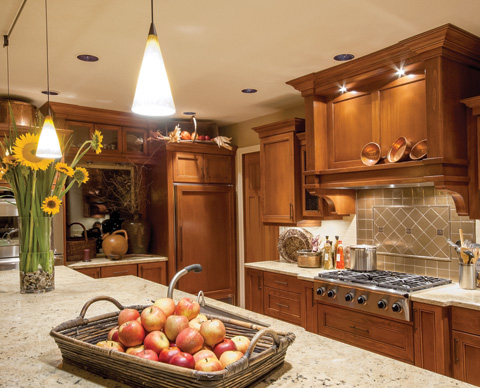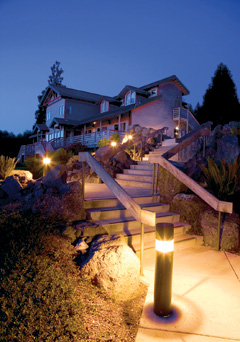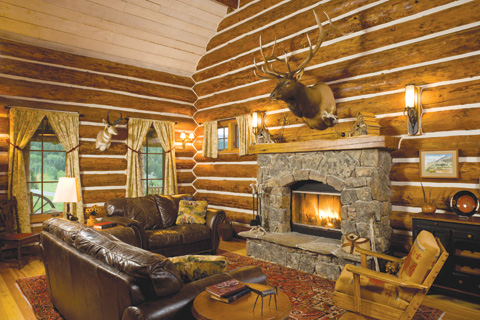An effective lighting plan adds beauty, comfort, and warmth to your home while accommodating the tasks of daily life. Balancing efficient light with rustic ambiance requires careful planning, but the results are worth it.
Since log and timber homes have unique lighting needs, it’s important to seek advice from a lighting designer with experience. You could ask your home builder for recommendations or locate a Certified Lighting Consultant through the American Lighting Association.
The first step is deciding on a lighting system. Unlike traditional walls, full-log walls are solid, making it difficult to change wiring later. The earlier you decide on a lighting system, the better.
While you may be accustomed to having light switches installed in each room, explore your options. Many homeowners prefer a lighting system that’s operated through automatic controls. You can preset light levels according to your preferences and change settings with the push of a button. This option gives you the flexibility to reset your controls at any time. Dimmers are also helpful.
Once you choose a lighting system, your builder can begin creating the channels in your logs that you will need later for wiring.
Design Basics
After deciding on a lighting system, you can move on to the fun part—choosing lighting types and fixtures that complement your taste and lifestyle! When planning, be sure to cover your bases. With the exception of closets and the laundry room, each room should have at least three light sources. That way, you’re sure to accommodate a variety of activities in each room.

Breadmaker
Ambient lighting refers to general lighting in a room. Having a central source of ambient light in each room is essential. It should provide a comfortable level of brightness without glare.
Recessed fixtures provide ambient light and counter the natural darkness of wood walls and ceilings. With wood walls, you cannot rely on reflection. However, recessed fixtures spread evenly around a room ensure that you have light directly above you for the illumination you need. Recessed fixtures are ideal for any type of ceiling and are installed with only the trim showing. They may appear plain, but they are one of the most versatile light sources available, providing task and accent light in addition to ambient light.
Chandeliers are an excellent source of ambient light for an entry way, living room, or dining room. From rustic to dazzling, you’re sure to find the perfect fit. Ceiling and wall-mounted fixtures are also great choices. Some wall-mounted fixtures are designed to match chandeliers and ceiling-mounted fixtures and can be bought in sets.
Task lighting is necessary when focusing on a particular project, such as cooking or reading. Floor and table lamps can add beauty to a room while providing needed task lighting. Another option is pendant lights, which can be suspended from the ceiling to provide lighting over counters or table areas. Pendant lights can free up the space occupied by table lamps.
Track lighting is also ideal for task lighting. You can adjust light according to your needs by moving, swiveling, or rotating the individual fixtures in any direction along the track. Lighting can be mounted under kitchen wall cabinets or in workshops and utility rooms for needed task lighting.
Accent lighting adds an artistic flair to any room by drawing attention to decorative features such as plants, paintings, or stonework. It is usually provided by recessed and track lighting or wall-mounted lights. Note that, to be effective, accent lighting must have at least three times as much light on the focal point as the general lighting surrounding it.
When you’re ready to look at accent lighting, think about each room’s assets. It’s time to put on your creative glasses!

Travis Manley
Do you have a stone fireplace? Wall grazing works well for highlighting stone and other textured surfaces. For a fireplace, install recessed downlights in the ceiling over the mantle to create dramatic shadow effect. To highlight draperies or textured walls, mount track lighting on the ceiling, 6 to 12 inches from the wall. Make sure fixtures are the same distance apart and aimed downward.
Another option for fireplaces or pictures on the wall is wall sconces, which draw attention to your point of interest while also supplying general lighting. Consider showcasing your dishes or antiques by installing low-voltage or LED strips under the shelves of a hutch or wall niche.
Outdoor Lighting
Of course, no home design would be complete without a great outdoor lighting scheme. Myriad options are available, but it’s important to check the building restrictions in your area before installing any hardware.
Your first consideration for outdoor illumination should be safety, especially near entrances, steps, and pathways. Wall lanterns work well on each side of the front door. If you have a porch or other overhang, you could also use recessed, chain-hung, or ceiling-mounted fixtures.
Several options are available for lighting up driveways, paths, and steps. Low-level path lights effectively outline driveways and walkways through close proximity. You could also post lanterns or mount lights on the side of the house. Low-voltage mini-lights could be concealed under steps or benches for a more subtle look.
It’s also wise to illuminate the outside of your garage and any outside walls of your house that may be in shadow. Motion sensors can help ensure safety and conserve energy. Photocells and timers make it so your lights automatically turn on at night and off during daylight.
Besides increasing security, outdoor lighting can transform an ordinary yard into a comfortable retreat. You can start out small by choosing one to two areas that you use frequently. Small projects can be completed quickly, and they don’t have to break your budget.
You can turn your patio into an evening sanctuary by concealing low-voltage or LED mini-lights under steps, railings, or benches. To illuminate a serving area, install a recessed spotlight on an adjacent roof overhang.
For more ideas, visit www.americanlightingassoc.com.

